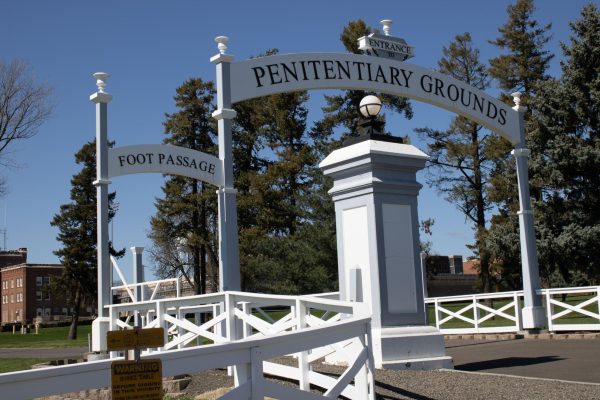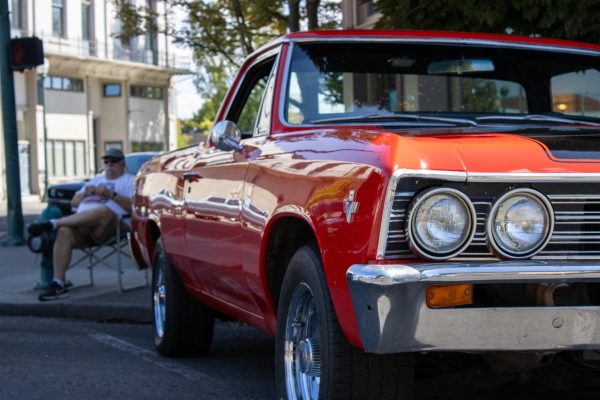Walla Walla: Sin City
Looking at the Brothels of the 19th and 20th Centuries
May 4, 2017
There is a piece of Walla Walla’s history that is swept under the records.
Walla Walla, home to hundreds of upscale vineyards, gourmet restaurants and boutiques is a favorite weekend getaway for many. Walking down main street, it’s hard to imagine Walla Walla being described as anything but cute and welcoming. However, a mere sixty years ago, Look Magazine rated Walla Walla the fourth most sinful city in the country. The boisterous saloons and taboo brothels that began in the late 19th century and lasted up until the early 1960s characterized this ‘Sin City’–an important but often forgotten piece of its past.
We talked to alumna Hannah Bartman, who did her senior thesis on the brothel at 210 West Main, and Dennis Crockett, Associate Professor of Art History and Visual Culture Studies, to unearth some details on the Walla Walla of yore.
In her research, Bartman relied on first person interviews with people who are passionate about Walla Walla and its history, as there are no real historical records of the brothels’ existence. A lot of it is based off of rumor and myth.
“People don’t really want to talk about it, obviously,” Bartman said.
As a flourishing, archetypal pioneer town, with a similar population size to Seattle in the 19th century, young men who missed their chance during the San Francisco gold rush flocked to Walla Walla to test their luck at the gold mines in nearby Idaho.
The mining drew Chinese immigrants, too; many became railroad workers and Chinatown was set up on Main Street, right where the Farmer’s Market is now.
Walla Walla became a town of mining, railroads and agriculture.
“So obviously it’s super masculine, like a lot of young, single males. I think that’s why it was a such a specific, archetypal Western [town],” Bartman said.
In such a masculine town, brothels were set up to serve men’s interests. Marked as “F.B.” (for “female boarding”) on historical maps, the brothels interestingly surrounded City Hall and the fire station. We went to check them out after a quick pit stop at Madame Josephine Wolfe’s grave.
Stop 1: the Graveyard
The first stop on our journey was the grave of Josephine Wolfe, Madame of the Coast House Brothel and her “girls” at the Mountain View Cemetery.
Wolfe, fondly called “Dutch Jo,” came to Walla Walla around 1860 when her husband was shot during a card game in San Francisco. With her she brought a ragtag group of girls, and the troop traveled throughout the Pacific Northwest, searching for towns where men, who worked in solitary jobs like mining and military work, might have an increased desire for woman.
Wolfe opened a well renowned brothel in Walla Walla called The Coast House whose patrons included many high standing citizens, from the mayor to members of the fire department. Crockett shared an anecdote passed down in Walla Walla history that illustrates the highly respected customers of her brothel.
“They say once there was some kind of emergency in the city and there was a shut down or there was an illness or something. But whatever it was, some bullshit story, but the mayor, the head of the fire department, and the chief of police were all locked in [the brothel] until they could get out,” Crockett said.
As with many of the details surrounding the brothels of Walla Walla, Jo Wolfe and her “girls” are women of great mystery. In her will, Jo Wolfe requested that all photos of her be disposed of and no documentation was kept about the names of the prostitutes due to the town’s exclusion of them as citizens.
Bartman commented on the women’s anonymity: “I tried to find out who the other girls were that worked there or that lived here and there is no information about them at all. People just don’t wanna talk about it.”
Arriving at Mountain View Cemetery we set off in search of the last surviving artifact of Jo Wolfe–her grave. Alissa spotted it first–a tall monument in a sea of small tombstones. According to Crockett, many of the prostitutes were buried around Wolfe’s grave, each marked solely with a first name, most of which were Sarah. Looking around the grave we found no headstones for the girls and were left to wonder where they had gone. Had they been removed or had the grass simply grown over them? There was no way to know, but none the less, the lack of recognition for these women’s lives points to the discrimination that these women faced day to day and the loss of these women’s story in the collective memory of Walla Walla.
As much as the lives and stories of these women have been swept under the rug, Jo Wolfe continues to be a heroic figure in the town’s imagination.
“She’s a celebrity in the city. She was a philanthropist. When she died she had all of her documents destroyed. But she’s a celebrity and her will was published. I found her will published in a Yakima newspaper. Right, that’s how much money and how generous she was. She’s giving a third of her money to orphans, a third of the money to the fire department. So yeah, fire department- go figure,” Crockett said.
As the life of Wolfe lives on through her self curated image, the lives of the prostitutes and the history surrounding the brothels of Walla Walla has been overlooked. The mystery continues to live on as we lack documentation of these events.
“Walla Walla has these certain parts of our history that we like to talk about, like the Pendleton Round Up, and we have these plays about all of these wonderful white savior things,” Bartman said. “And this is another part of our history that is skimmed over and not talked about, and that is shown by the fact that we don’t know anyone who was involved in it or wants to talk about it.”
Stop 2: the Brothels
Crockett showed us images of brothels from old Sanborn maps, made for the purpose of fire insurance. The maps served as footprints for old buildings, made every few years.
Crockett also drew our attention to the State Hotel, a large brothel on Rose and 3rd near City Hall. Back then, there was a fire house downstairs and city hall upstairs.
Since there is so little known about the brothels, we decided to dig around in the archives for the letters and interviews that comprise Walla Walla’s knowledge of the brothels.
A letter to the archives from Ward Gardner read: “West of the fire station on Rose Street to the building on the corner…These were houses of ill repute.”
Just as there is no record of the prostitutes since they were not listed as residents, there is no viable record of the brothels’ existence, as they were marked with the unofficial designator “F.B.” (for female boarding) on the maps.
“This is what we get from the Sanborn maps. We have to imagine. We can only use our imagination. We have no idea about what these buildings look like,” Crockett said. “This is like make believe. There are a bunch of signifiers and you can start to put it all together in your head. But it only exists on these maps. We don’t have photographs.”
It was common for the brothels to be disguised as hotels or saloons, with the brothels tucked away upstairs and in the back.
However, everyone knew about them.
An anonymous note found in the archives read: “On weekends, you could hardly get through the crowds off such men gathered around the saloons of Main Street between 3rd and 6th. A woman didn’t dare walk on the north side of Main where most saloons were.”
Crockett added, “No families were living right downtown. The nearest families would be like behind Safeway or on Birch Street. Right, so downtown: Main, Alder, Rose Streets, that’s where business is done. Thats men’s domain.”
These areas used to be taboo. Now it’s the place for a fun Saturday morning outing to the Farmer’s Market, which is down the street from a former brothel, or attending an event at Main Street Studios, which is right across the street from a former brothel.
These areas impacted Whitman students much differently back then than they do now.
Stephen Penrose was strict about keeping females on campus. No sorority housing was allowed because of the brothels and women weren’t allowed to go further than the Beta House, which was a women’s residence before it became a frat house. As for the Whitman men, according to they frequented the brothels, according to Crockett.
In addition to college students, firefighters and policemen were huge patrons of the brothels.
“Friday was big brothel day for the police department,”Crockett said. “The police department would go around town doing inspections and basically end up at the brothel and then kill the rest of the day.”
Their fun was presumably put to an end once the “Red Light” law was enacted. A newspaper article from June 10, 1913 announced that “Houses of Prostitution Will Close Tonight” and “members of the police department have given instructions to keep close watch on the rooming houses of the city and effort will be made to keep the city clean.” Prostitution was officially made illegal in 1914.
The brothel on West Main even had a sign up that said “no girls” to lead people away from thinking that it was no longer a brothel. However, people knew that it was still a brothel and didn’t start persecuting brothel owners until the 1960s in an effort to change Walla Walla’s “sin city” image.
Ironically, the enforcers of the “Red Light” law doubled as patrons. In Outlaws of the Pacific Northwest, Bill Gulick writes that a prostitute “had scarlet fever and quarantined the house for two weeks. None of the people present were permitted to leave. The list of detainees included the mayor, fire chief, police chief, a Catholic priest, an Episcopalian minister, a newspaper publisher, and six merchants” (p. 64).
There is even rumored to be tunnels underground for people to use to get to brothels, but Crockett doesn’t buy it.
“Those are the stupid things we cling to! We cling to stupid anecdotes about people’s lives, generations of people and it’s all a mystery we just really don’t know,” Crockett said. “We don’t have those autobiographies of My Life in Walla Walla as a Chinese Man in the Early 20th Century. That book was never written … Or maybe it’s in a tunnel somewhere.”
“Sin City” had run its course. By 1960, the archetypal Western pioneer town was no longer enthralling.
“This was a really downbeat city. Walla Walla was not a desirable place to be in 1960,” Crockett said. “It was basically a dying city. Decaying. Everyone was moving out to the suburbs. Downtown was just saloons and run down buildings and then they started knocking them all down. This is all part of that idea of urban renewal, clearing out the brothels.”
Now all this has disappeared, leaving a cute, naive little Walla Walla in its place.










Jackie Perry Arrington • Jan 15, 2024 at 4:16 pm
My brother and I use to walk the “skid row” “red light district” in the 50’s and 60’s looking for our mother who frequented the area. There was a prostitute named “Rosie” that would be standing out side a tavern on Main Street and she knew our mother. We would ask her if she knew where our mother was and if she knew she would tell us. As for the underground places in the “brothels” or “taverns” I know first hand they were there. My brother and I would sneak in to find our mother. It was a horrible time for my brother and I, but I remember it so well.
Doug Packard • Apr 10, 2021 at 4:03 pm
The brothels “Waldorf” and across the street the “Astoria” were functioning in the late 50s as many Camp Hanford GIs can attest to. The name Waldorf was visible (and maybe still is) from the street.
Andrea • Mar 12, 2021 at 6:05 am
Crockett is Wrong !!!!! Or at least hiding the truth.There indeed is a whole town underground Walla Wallas downtown. I went down there in a 4th grade trip . We were too young to go into the speak easy brothel side. That was only available to hs students and adults. We got to see the area where the chinese lived. They couldnt be above ground after 9 pm or they could be shot. A whole downtown underground. They did allow us into a casino front room where they showed us how the strings and bells worked and the red light alarm that would go off once the bells were pulled .
Matthew McKern • Jan 23, 2021 at 9:06 pm
I have a few details to add.
In the early 2000s, I had a neighbor whose family owned a drug store below what he called a “riding academy.” The store closed in the 1960s when chains like Payless opened. But he liked to say the business closed because of all the f*cking overhead.”
He described how his father and uncle, members of the police department, would take “brown bag” collections from these establishments, and he was personally asked to gather these payments himself.
From his account, prostitution went under based on two factors—the hiring of a city manager whose wife demanded laws on the books be enforced, and perhaps more crucially, the influx of combine harvesters which eliminated the influx of huge crews of seasonal workers who supported the industry.
Roberta Paulson • Jun 15, 2020 at 6:51 pm
I think that this article would have been more realistic if the right people had been interviewed. The houses were closed in Oct./Nov. If 1960. They were turned into hotels for single men at that point and used that way for several years.
The State Hotel stood for many more years where many single Chinese men lived. When it was torn down the did find tunnels. This could all be found in the newspaper archives!
The Josephine Wolfe character has been enacted by Lois Hahn at Fort Walla Walla for many years.
I was a student at Whitman from 1958 to 1963 and later worked as a caseworker for many of the men living in the hotels. As for downtown Walla Walla being a dying place in the 60’s, there were loads of great stores shopping was good and busy. I think that the tone of this article is derisive and not at all well informed.
Brenda Stinebaugh • Aug 15, 2018 at 6:41 am
Outstanding article.